Impact of the ‘13th Five-Year Plan’ Policy on Air Quality in Pearl River Delta, China: A Case Study of Haizhu District in Guangzhou City Using WRF-Chem
Abstract
1. Introduction
2. Data and Model Experiment
2.1. Observation Data
2.2. Emission Inventory and Scenarios
2.2.1. Emission Inventory
2.2.2. Emission Scenarios
2.3. WRF-Chem Model Setup
2.3.1. Description of WRF-Chem Model
2.3.2. Configuration of WRF-Chem
2.3.3. Cases Setup
3. Results and Discussion
3.1. Air Quality in Haizhu in 2015
3.1.1. Overview
3.1.2. Air Quality during Pollution Episodes
3.2. Evaluation of WRF-Chem Model Performance
3.3. Effect of 13th FYP on Overall Air Quality in Haizhu in 2020
3.4. Effect of 13th FYP on Air Quality during Heavy Pollution Episodes in Haizhu in 2020
4. Conclusions
Supplementary Materials
Author Contributions
Funding
Acknowledgments
Conflicts of Interest
References
- Gulia, S.; Shiva, N.S.M.; Khare, M.; Khanna, I. Urban air quality management—A review. Atmos. Pollut. Res. 2015, 6, 286–304. [Google Scholar] [CrossRef]
- SC (State Council of People’s Republic of China. Air Pollution Control Action Plan. 2013. Available online: http://www.gov.cn/zwgk/2013-09/12/content_2486773.htm (accessed on 23 November 2018).
- CAA (Clean Air Asia). China Air 2015—Air Pollution Prevention and Control Progress in Chinese Cities. 2015. Available online: http://cleanairasia.org/wp-content/uploads/2016/03/ChinaAir2015-report.pdf (accessed on 23 November 2018).
- CAA (Clean Air Asia). China Air 2016—Air Pollution Prevention and Control Progress in Chinese Cities. 2016. Available online: http://www.allaboutair.cn/a/cbw/bg/2016/0822/472.html (accessed on 23 November 2018).
- BJMBEE (Beijing Municipal Bureau of Ecoloy and Environment). Beijing Environmental Statement 2015. 2015. Available online: http://www.bjepb.gov.cn/bjhrb/xxgk/ywdt/hjzlzk/hjzkgb65/index.html (accessed on 23 November 2018).
- SHEP (Shanghai Environmental Protection). Shanghai Air Quality Report. 2015. Available online: http://www.sepb.gov.cn/hb/fa/cms/shhj/list_login.jsp?channelId=5157 (accessed on 23 November 2018).
- Zhan, J.; Liu, Y.; Lin, L.; Ding, H.; Xu, W. Investigation of spatial and temporal association of PM2.5 pollution during the winter of 2014 in typical cities of Pearl River Delta. Res. Environ. Sci. 2017, 30, 110–120. [Google Scholar] [CrossRef]
- Ma, X.; Jia, H. Particulate matter and gaseous pollutions in three megacities over China: Situation and implication. Atmos. Environ. 2016, 140, 476–494. [Google Scholar] [CrossRef]
- Li, M.; Song, Y.; Mao, Z.; Liu, M.; Huang, X. Impacts of thermal circulations induced by urbanization on ozone formation in the Pearl River Delta region, China. Atmos. Environ. 2016, 127, 382–392. [Google Scholar] [CrossRef]
- Wang, T.; Xue, L.; Brimblecombe, P.; Lam, Y.F.; Li, L.; Zhang, L. Ozone pollution in China: A review of concentrations, meteorological influences, chemical precursors, and effects. Sci. Total Environ. 2017, 575, 1582–1596. [Google Scholar] [CrossRef]
- SC (State Council of People’s Republic of China). Environmental Protection 13th Five-Year Plan. 2016. Available online: http://www.gov.cn/zhengce/content/2016-12/05/content_5143290.htm (accessed on 23 November 2018).
- PGGZ (People’s Government of Guangzhou). Guangzhou Environmental Protection 13th Five-Year Plan. 2016. Available online: http://www.gz.gov.cn/gzgov/s2812/201612/467e946dfcb048c0a7bff56655808c60.shtml (accessed on 23 November 2018).
- Wang, N.; Lyu, X.P.; Deng, X.J.; Guo, H.; Deng, T.; Li, Y.; Yin, C.Q.; Li, F.; Wang, S.Q. Assessment of regional air quality resulting from emission control in the Pearl River Delta region, southern China. Sci. Total Environ. 2016, 573, 1554–1565. [Google Scholar] [CrossRef]
- Liu, Y.H.; Liao, W.Y.; Lin, X.F.; Li, L.; Zeng, X.L. Assessment of Co-benefits of vehicle emission reduction measures for 2015–2020 in the Pearl River Delta region, China. Environ. Pollut. 2017, 223, 62–72. [Google Scholar] [CrossRef]
- Maji, K.J.; Dikshit, A.K.; Arora, M.; Deshpande, A. Estimating premature mortality attributable to PM2.5 exposure and benefit of air pollution control policies in China for 2020. Sci. Total Environ. 2018, 612, 683–693. [Google Scholar] [CrossRef]
- Yang, X.; Teng, F. The air quality co-benefit of coal control strategy in China. Resour. Conserv. Recycl. 2016, 129, 373–382. [Google Scholar] [CrossRef]
- Wang, Z.; Pan, L.; Li, Y.; Zhang, D.; Ma, J.; Sun, F.; Xu, W.; Wang, X. Assessment of air quality benefits from the national pollution control policy of thermal power plants in China: A numerical simulation. Atmos. Environ. 2015, 106, 288–304. [Google Scholar] [CrossRef]
- Qiu, X.; Duan, L.; Cai, S.; Yu, Q.; Wang, S.; Chai, F.; Gao, J.; Li, Y.; Xu, Z. Effect of current emission abatement strategies on air quality improvement in China: A case study of Baotou, a typical industrial city in Inner Mongolia. J. Environ. Sci. 2017, 57, 383–390. [Google Scholar] [CrossRef] [PubMed]
- Cai, S.; Wang, Y.; Zhao, B.; Wang, S.; Chang, X.; Hao, J. The impact of the “air pollution prevention and control action plan” on PM2. 5 concentrations in jing-jin-ji region during 2012–2020. Sci. Total Environ. 2017, 580, 197–209. [Google Scholar] [CrossRef] [PubMed]
- Li, M.; Patiño-Echeverri, D. Estimating benefits and costs of policies proposed in the 13th FYP to improve energy efficiency and reduce air emissions of China’s electric power sector. Energy Policy 2017, 111, 222–234. [Google Scholar] [CrossRef]
- Wei, W.; Li, P.; Wang, H.; Song, M. Quantifying the effects of air pollution control policies: A case of Shanxi province in China. Atmos. Pollut. Res. 2017, 9, 429–438. [Google Scholar] [CrossRef]
- Guo, J.; He, J.; Liu, H.; Miao, Y.; Liu, H.; Zhai, P. Impact of various emission control schemes on air quality using WRF-Chem during APEC China 2014. Atmos. Environ. 2016, 140, 311–319. [Google Scholar] [CrossRef]
- Xu, H.M.; Tao, J.; Ho, S.S.H.; Ho, K.F.; Cao, J.J.; Li, N.; Chow, J.C.; Wang, G.H.; Han, Y.M.; Zhang, R.J.; et al. Characteristics of fine particulate non-polar organic compounds in Guangzhou during the 16th Asian Games: Effectiveness of air pollution controls. Atmos. Environ. 2013, 76, 94–101. [Google Scholar] [CrossRef]
- Shen, X.J.; Sun, J.Y.; Zhang, X.Y.; Zhang, Y.M.; Zhang, L.; Fan, R.X.; Zhang, Z.X.; Zhang, X.L.; Zhou, H.G.; Zhou, L.Y.; et al. The influence of emission control on particle number size distribution and new particle formation during China’s V-Day parade in 2015. Sci. Total Environ. 2016, 573, 409–419. [Google Scholar] [CrossRef]
- Tan, J.H.; Duan, J.C.; Chen, D.H.; Wang, X.H.; Guo, S.J.; Bi, X.H.; Sheng, G.Y.; He, K.B.; Fu, J.M. Chemical characteristics of haze during summer and winter in Guangzhou. Atmos. Res. 2009, 94, 238–245. [Google Scholar] [CrossRef]
- Wang, M.; Cao, C.; Li, G.; Singh, R.P. Analysis of a severe prolonged regional haze episode in the Yangtze River Delta, China. Atmos. Environ. 2015, 102, 112–121. [Google Scholar] [CrossRef]
- Zhang, L.; Wang, T.; Lv, M.; Zhang, Q. On the severe haze in Beijing during January 2013: Unraveling the effects of meteorological anomalies with WRF-Chem. Atmos. Environ. 2015, 104, 11–21. [Google Scholar] [CrossRef]
- Ding, A.; Wang, T.; Zhao, M.; Wang, T.; Li, Z. Simulation of sea-land breezes and a discussion of their implications on the transport of air pollution during a multi-day ozone episode in the Pearl River Delta of China. Atmos. Environ. 2004, 38, 6737–6750. [Google Scholar] [CrossRef]
- Shen, J.; Zhang, Y.; Wang, X.; Li, J.; Chen, H.; Liu, R.; Zhong, L.; Jiang, M.; Yue, D.; Chen, D.; et al. An ozone episode over the Pearl River Delta in October 2008. Atmos. Environ. 2015, 122, 852–863. [Google Scholar] [CrossRef]
- Zhao, H.; Wang, S.; Wang, W.; Liu, R.; Zhou, B. Investigation of ground-level ozone and high-pollution episodes in a megacity of Eastern China. PLoS ONE. 2015, 10, e0131878. [Google Scholar] [CrossRef] [PubMed]
- Xu, J.; Zhang, Y.; Fu, J.S.; Zheng, S.; Wang, W. Process analysis of typical summertime ozone episodes over the Beijing area. Sci. Total Environ. 2008, 399, 147–157. [Google Scholar] [CrossRef]
- Qu, Y.; An, J.; Li, J.; Chen, Y.; Li, Y.; Liu, X.; Hu, M. Effects of NOx and VOCs from five emission sources on summer surface O3 over the Beijing-Tianjin-Hebei region. Adv. Atmos. Sci. 2014, 31, 787–800. [Google Scholar] [CrossRef]
- MEE (Ministry of Ecology and Environment of People’s Republic of China). China Vehicle Environmental Management Annual Report 2017. 2017. Available online: http://dqhj.mee.gov.cn/jdchjgl/zhgldt/201706/P020170605550637870889.pdf (accessed on 23 November 2018).
- EPGD (Environmental Protection of Guangdong Province). Guangzhou Environmental Protection’s Implementation of Grid Control. 2016. Available online: http://www.gdep.gov.cn/zwxx_1/hbxx/201607/t20160725_213142.html (accessed on 23 November 2018).
- EPGD (Environmental Protection of Guangdong Province). 2017 Guangdong Cities Air Quality Ranking Released, Guangdong Achieved Targets for Three Years. 2018. Available online: http://mp.weixin.qq.com/s/YKKBj9pncWaq67lFq0l6mQ (accessed on 23 November 2018).
- Wang, J.; Kwan, M.P.; Ma, L. Delimiting service area using adaptive crystal-growth Voronoi diagrams based on weighted planes: A case study in Haizhu District of Guangzhou in China. Appl. Geogr. 2014, 50, 108–119. [Google Scholar] [CrossRef]
- Zhang, Z.; Li, H.; Liu, H.; Ni, R.; Li, J.; Deng, L.; Lu, D.; Cheng, X.; Duan, P.; Li, W. A preliminary analysis of the surface chemistry of atmospheric aerosol particles in a typical urban area of Beijing. J. Environ. Sci. 2016, 47, 71–81. [Google Scholar] [CrossRef]
- Ling, Z.H.; Zhao, J.; Fan, S.J.; Wang, X.M. Sources of formaldehyde and their contributions to photochemical O3 formation at an urban site in the Pearl River Delta, southern China. Chemosphere 2017, 168, 1293–1301. [Google Scholar] [CrossRef]
- HZEPB (Haizhu Environmental Protection Bureau). Haizhu Environmental Protection Bureau 2015 Work Report and 2016 Key Work. 2016. Available online: http://zwgk.haizhu.gov.cn/HZ12/201605/t20160526_346735.html (accessed on 23 November 2018).
- HZEPB (Haizhu Environmental Protection Bureau). Haizhu Environmental Protection Bureau 2016 Work Report and 2017 Key Work. 2017. Available online: http://zwgk.haizhu.gov.cn/HZ12/201703/t20170324_392921.html (accessed on 23 November 2018).
- CNGIPSP (China National Geographic Information Public Service Platform). GS(2017)508-1100471 Map Data. 2017. Available online: http://map.tianditu.com/ (accessed on 23 November 2018).
- Gong, J.; Hu, Z.; Chen, W.; Liu, Y.; Wang, J. Urban expansion dynamics and modes in metropolitan Guangzhou, China. Land Use Policy. 2018, 72, 100–109. [Google Scholar] [CrossRef]
- He, K. Multi-resolution Emission Inventory for China (MEIC): Model framework and 1990–2010 anthropogenic emissions. In AGU Fall Meeting Abstracts; Fall Meeting 2012 of American Geophysical Union; American Geophysical Union: San Francisco, CA, USA, 3–7 December 2012; abstract id. A32B-05; Available online: http://adsabs.harvard.edu/abs/2012AGUFM.A32B..05H (accessed on 23 November 2018).
- Guenther, A.; Zimmerman, P.; Wildermuth, M. Natural volatile organic compound emission rate estimates for US woodland landscapes. Atmos. Environ. 1994, 28, 1197–1210. [Google Scholar] [CrossRef]
- Shaw, W.J.; Allwine, K.J.; Fritz, B.G.; Rutz, F.C.; Rishel, J.P.; Chapman, E.G. An evaluation of the wind erosion module in DUSTRAN. Atmos. Environ. 2008, 42, 1907–1921. [Google Scholar] [CrossRef]
- Gong, S.L.; Barrie, L.A.; Lazare, M. Canadian Aerosol Module (CAM): A size-segregated simulation of atmospheric aerosol processes for climate and air quality models: 2. Global sea-salt aerosol and its budgets. J. Geophys. Res. Atmos. 2002, 107, 4779. [Google Scholar] [CrossRef]
- Lei, Y.; Zhang, Q.; He, K.B.; Streets, D.G. Primary anthropogenic aerosol emission trends for China, 1990–2005. Atmos. Chem. Phys. 2011, 11, 931–954. [Google Scholar] [CrossRef]
- Li, Q.; Zhang, L.; Wang, T.; Tham, Y.J.; Ahmadov, R.; Xue, L.; Zhang, Q.; Zheng, J. Impacts of heterogeneous uptake of dinitrogen pentoxide and chlorine activation on ozone and reactive nitrogen partitioning: Improvement and application of the WRF-Chem model in southern China. Atmos. Chem. Phys. 2016, 16, 14875. [Google Scholar] [CrossRef]
- PGGZ (People’s Government of Guangzhou). Guangzhou Air Quality Targets Plan (2016–2025). 2017. Available online: http://www.gz.gov.cn/gzgov/s2811/201712/57727a1d77354f5dbc22bb5831aa7d93.shtml (accessed on 23 November 2018).
- MEE (Ministry of Ecology and Environment of People’s Republic of China). Announcement on the publication of four technical guidelines (Technical Guidelines for the Primary Source Emission Inventory of Atmospheric Fine Particles (Trial), Technical Guidelines for the Emission Inventory of Atmospheric Volatile Organic Compounds (Trial), Technical Guidelines for the Emission Inventory of Atmospheric Ammonia Source (Trial), and Technical Guidelines for Priority Control of Atmospheric Pollution Sources (Trial)). 2014. Available online: http://www.mee.gov.cn/gkml/hbb/bgg/201408/t20140828_288364.htm (accessed on 23 November 2018).
- MEE (Ministry of Ecology and Environment of People’s Republic of China). Announcement on the Publication of Five Technical Guidelines (Technical Guidelines for the Primary Source Emission Inventory of Inhalable Particulate Matter (Trial), Technical Guidelines for the Air Pollutant Emission Inventory for Road Vehicles (Trial), Technical Guidelines for the Air Pollutant Emission Inventory of Non-Road Mobile Source (Trial), Technical Guidelines for the Air Pollutant Emission Inventory for Biomass Combustion Sources (Trial), Technical Guidelines for the Emission Inventory of Dust Particles Discharge (Trial)). 2014. Available online: http://www.mee.gov.cn/gkml/hbb/bgg/201501/t20150107_293955.htm (accessed on 23 November 2018).
- Zheng, J.Y.; Zhang, L.J.; Che, W.W.; Zheng, Z.Y.; Yin, S.S. A highly resolved temporal and spatial air pollutant emission inventory for the Pearl River Delta region, China and its uncertainty assessment. Atmos. Environ. 2009, 43, 5112–5122. [Google Scholar] [CrossRef]
- Zhao, X.Y.; Hu, Q.H.; Wang, X.M.; Ding, X.; He, Q.F.; Zhang, Z.; Shen, R.Q.; Lü, S.J.; Liu, T.Y.; Fu, X.X.; et al. Composition profiles of organic aerosols from Chinese residential cooking: Case study in urban Guangzhou, south China. J. Atmos. Chem. 2015, 72, 1–18. [Google Scholar] [CrossRef]
- PGGZ (People’s Government of Guangzhou). Guangzhou Transportation Development 13th Five-Year Plan. 2016. Available online: http://www.gz.gov.cn/gzgov/s2812/201611/a8ee48d726b649caaba3e4f12572feae.shtml (accessed on 23 November 2018).
- NOAA (National Oceanic and Atmospheric Administration). Weather Research and Forecasting Model Coupled to Chemistry (WRF-Chem). 2017. Available online: https://ruc.noaa.gov/wrf/wrf-chem/ (accessed on 23 November 2018).
- NCAR (National Center for Atmospheric Research). Atmospheric Chemistry Observation & Modeling: WRF-CHEM. 2018. Available online: https://www2.acom.ucar.edu/wrf-chem (accessed on 23 November 2018).
- He, H.; Tie, X.; Zhang, Q.; Liu, X.; Gao, Q.; Li, X.; Gao, Y. Analysis of the causes of heavy aerosol pollution in Beijing, China: A case study with the WRF-Chem model. Particuology 2015, 20, 32–40. [Google Scholar] [CrossRef]
- Emmons, L.K.; Walters, S.; Hess, P.G.; Lamarque, J.F.; Pfister, G.G.; Fillmore, D.; Granier, C.; Guenther, A.; Kinnison, D.; Laepple, T.; et al. Description and evaluation of the Model for Ozone and Related chemical Tracers, version 4 (MOZART-4). Geosci. Model Dev. 2010, 3, 43–67. [Google Scholar] [CrossRef]
- Stockwell, W.R.; Middleton, P.; Chang, J.S.; Tang, X. The second generation regional acid deposition model chemical mechanism for regional air quality modeling. J. Geophys. Res. Atmos. 1990, 95, 16343–16367. [Google Scholar] [CrossRef]
- Ackermann, I.J.; Hass, H.; Memmesheimer, M.; Ebel, A.; Binkowski, F.S.; Shankar, U.M.A. Modal aerosol dynamics model for Europe: Development and first applications. Atmos. Environ. 1998, 32, 2981–2999. [Google Scholar] [CrossRef]
- Schell, B.; Ackermann, I.J.; Hass, H.; Binkowski, F.S.; Ebel, A. Modeling the formation of secondary organic aerosol within a comprehensive air quality model system. J. Geophys. Res. Atmos. 2001, 106, 28275–28293. [Google Scholar] [CrossRef]
- MEE (Ministry of Ecology and Environment of People’s Republic of China). Technical Regulation on Ambient Air Quality Index (on trial) (HJ 633-2012). 2016. Available online: http://www.gov.cn/zwgk/2012-03/02/content_2081374.htm (accessed on 23 November 2018).
- EPGD (Environmental Protection of Guangdong Province). Guangdong-Hong Kong-Macao Pearl River Delta Regional Air Quality Monitoring Network: Report of Monitoring Results 2015. 2016. Available online: http://www.gdep.gov.cn/hjjce/kqjc/index_1.html (accessed on 23 November 2018).
- GZEP (Guangzhou Environmental Protection Bureau). Guangzhou Air Quality Report 2015. 2016. Available online: http://www.gzepb.gov.cn/zwgk/hjgb/ (accessed on 23 November 2018).
- WHO (World Health Organization). WHO Air Quality Guidelines (Global Update 2005). 2005. Available online: http://apps.who.int/iris/bitstream/handle/10665/69477/WHO_SDE_PHE_OEH_06.02_eng.pdf;jsessionid=0757FBBE71232DE20E0BB5E7C64E45A1?sequence=1 (accessed on 23 November 2018).
- MEE (Ministry of Ecology and Environment of People’s Republic of China) Technical Regulations for Urban Environmental Air Quality Ranking. 2018. Available online: http://www.mee.gov.cn/gkml/sthjbgw/bgtwj/201808/W020180815576019704248.pdf (accessed on 23 November 2018).
- Tong, C.H.M.; Yim, S.H.L.; Rothenberg, D.; Wang, C.; Lin, C.Y.; Chen, Y.D.; Lau, N.C. Assessing the impacts of seasonal and vertical atmospheric conditions on air quality over the Pearl River Delta region. Atmos. Environ. 2018, 180, 69–78. [Google Scholar] [CrossRef]
- Zou, B.B.; Huang, X.F.; Zhang, B.; Dai, J.; Zeng, L.W.; Feng, N.; He, L.Y. Source apportionment of PM2.5 pollution in an industrial city in southern China. Atmos. Pollut. Res. 2017, 8, 1193–1202. [Google Scholar] [CrossRef]
- Malek, E.; Davis, T.; Martin, R.S.; Silva, P.J. Meteorological and environmental aspects of one of the worst national air pollution episodes (January, 2004) in Logan, Cache Valley, Utah, USA. Atmos. Res. 2006, 79, 108–122. [Google Scholar] [CrossRef]
- Cui, H.; Chen, W.; Dai, W.; Liu, H.; Wang, X.; He, K. Source apportionment of PM2.5 in Guangzhou combining observation data analysis and chemical transport model simulation. Atmos. Environ. 2015, 116, 262–271. [Google Scholar] [CrossRef]
- Song, H.; Wang, K.; Zhang, Y.; Hong, C.; Zhou, S. Simulation and evaluation of dust emissions with WRF-Chem (v3. 7.1) and its relationship to the changing climate over East Asia from 1980 to 2015. Atmos. Environ. 2017, 167, 511–522. [Google Scholar] [CrossRef]
- Gao, J.; Zhu, B.; Xiao, H.; Kang, H.; Hou, X.; Shao, P. A case study of surface ozone source apportionment during a high concentration episode, under frequent shifting wind conditions over the Yangtze River Delta, China. Sci. Total Environ. 2016, 544, 853–863. [Google Scholar] [CrossRef]
- Hong, C.; Zhang, Q.; He, K.; Guan, D.; Li, M.; Liu, F.; Zheng, B. Variations of China’s emission estimates: Response to uncertainties in energy statistics. Atmos. Chem. Phys. 2017, 17, 1227–1239. [Google Scholar] [CrossRef]
- Huo, H.; Yao, Z.; Zhang, Y.; Shen, X.; Zhang, Q.; He, K. On-board measurements of emissions from diesel trucks in five cities in China. Atmos. Environ. 2012, 54, 159–167. [Google Scholar] [CrossRef]
- Zheng, B.; Zhang, Q.; Tong, D.; Chen, C.; Hong, C.; Li, M.; Geng, G.; Lei, Y.; Huo, H.; He, K. Resolution dependence of uncertainties in gridded emission inventories: A case study in Hebei, China. Atmos. Chem. Phys. 2017, 17, 921–933. [Google Scholar] [CrossRef]
- Ahmadov, R.; McKeen, S.A.; Robinson, A.L.; Bahreini, R.; Middlebrook, A.M.; De Gouw, J.A.; Meagher, J.; Hsie, E.Y.; Edgerton, E.; Shaw, S.; et al. A volatility basis set model for summertime secondary organic aerosols over the eastern United States in 2006. J. Geophys. Res. Atmos. 2012, 117, D6. [Google Scholar] [CrossRef]
- Li, Q.; Zhang, L.; Wang, T.; Wang, Z.; Fu, X.; Zhang, Q. “New” Reactive Nitrogen Chemistry Reshapes the Relationship of Ozone to Its Precursors. Environ. Sci. Technol. 2018, 52, 2810–2818. [Google Scholar] [CrossRef] [PubMed]
- Banks, R.F.; Baldasano, J.M. Impact of WRF model PBL schemes on air quality simulations over Catalonia, Spain. Sci. Total Environ. 2016, 572, 98–113. [Google Scholar] [CrossRef] [PubMed]
- Shin, H.H.; Hong, S.Y. Intercomparison of planetary boundary-layer parametrizations in the WRF model for a single day from CASES-99. Bound. Layer Meteorol. 2011, 139, 261–281. [Google Scholar] [CrossRef]
- Hu, X.M.; Nielsen-Gammon, J.W.; Zhang, F. Evaluation of three planetary boundary layer schemes in the WRF model. J. Appl. Meteorol. Climatol. 2010, 49, 1831–1844. [Google Scholar] [CrossRef]
- Hong, S.Y.; Noh, Y.; Dudhia, J. A new vertical diffusion package with an explicit treatment of entrainment processes. Mon. Weather Rev. 2006, 134, 2318–2341. [Google Scholar] [CrossRef]
- Schutgens, N.A.; Gryspeerdt, E.; Weigum, N.; Tsyro, S.; Goto, D.; Schulz, M.; Stier, P. Will a perfect model agree with perfect observations? The impact of spatial sampling. Atmos. Chem. Phys. 2016, 16, 6335–6353. [Google Scholar] [CrossRef]
- Solazzo, E.; Bianconi, R.; Hogrefe, C.; Curci, G.; Tuccella, P.; Alyuz, U.; Balzarini, A.; Baró, R.; Bellasio, R.; Bieser, J.; et al. Evaluation and error apportionment of an ensemble of atmospheric chemistry transport modeling systems: Multivariable temporal and spatial breakdown. Atmos. Chem. Phys. 2017, 17, 3001–3054. [Google Scholar] [CrossRef]
- Solazzo, E.; Hogrefe, C.; Colette, A.; Garcia-Vivanco, M.; Galmarini, S. Advanced error diagnostics of the CMAQ and Chimere modelling systems within the AQMEII3 model evaluation framework. Atmos. Chem. Phys. 2017, 17, 10435–10465. [Google Scholar] [CrossRef]
- Koch, R.; Knispel, R.; Elend, M.; Siese, M.; Zetzsch, C. Consecutive reactions of aromatic-OH adducts with NO, NO2 and O2: Benzene, naphthalene, toluene, m-and p-xylene, hexamethylbenzene, phenol, m-cresol and aniline. Atmos. Chem. Phys. 2007, 7, 2057–2071. [Google Scholar] [CrossRef]
- Barthelmie, R.J.; Pryor, S.C. Secondary organic aerosols: Formation potential and ambient data. Sci. Total Environ. 1997, 205, 167–178. [Google Scholar] [CrossRef]
- Li, Y.J.; Sun, Y.; Zhang, Q.; Li, X.; Li, M.; Zhou, Z.; Chan, C.K. Real-time chemical characterization of atmospheric particulate matter in China: A review. Atmos. Environ. 2017, 158, 270–304. [Google Scholar] [CrossRef]
- Tao, J.; Zhang, L.; Cao, J.; Zhong, L.; Chen, D.; Yang, Y.; Chen, D.; Chen, L.; Zhang, Z.; Wu, Y.; et al. Source apportionment of PM2.5 at urban and suburban areas of the Pearl River Delta region, south China-With emphasis on ship emissions. Sci. Total Environ. 2017, 574, 1559–1570. [Google Scholar] [CrossRef] [PubMed]
- Yin, X.; Huang, Z.; Zheng, J.; Yuan, Z.; Zhu, W.; Huang, X.; Chen, D. Source contributions to PM2.5 in Guangdong province, China by numerical modeling: Results and implications. Atmos. Res. 2017, 186, 63–71. [Google Scholar] [CrossRef]
- Sillman, S. The relation between ozone, NOx and hydrocarbons in urban and polluted rural environments. Atmos. Environ. 1999, 33, 1821–1845. [Google Scholar] [CrossRef]
- Xue, L.K.; Wang, T.; Gao, J.; Ding, A.J.; Zhou, X.H.; Blake, D.R.; Wang, X.F.; Saunders, S.M.; Fan, S.J.; Zuo, H.C.; et al. Ground-level ozone in four Chinese cities: Precursors, regional transport and heterogeneous processes. Atmos. Chem. Phys. 2014, 14, 13175–13188. [Google Scholar] [CrossRef]
- Grewe, V. A generalized tagging method. Geosci. Model Dev. 2013, 6, 247–253. [Google Scholar] [CrossRef]

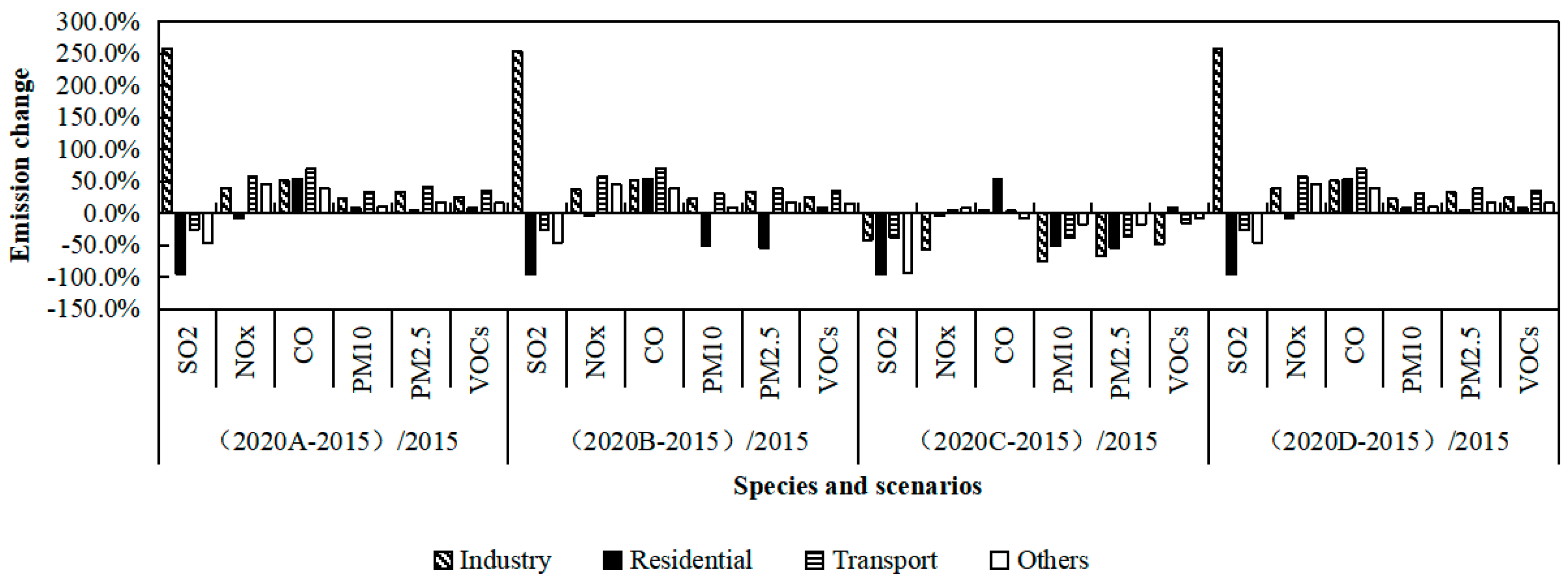
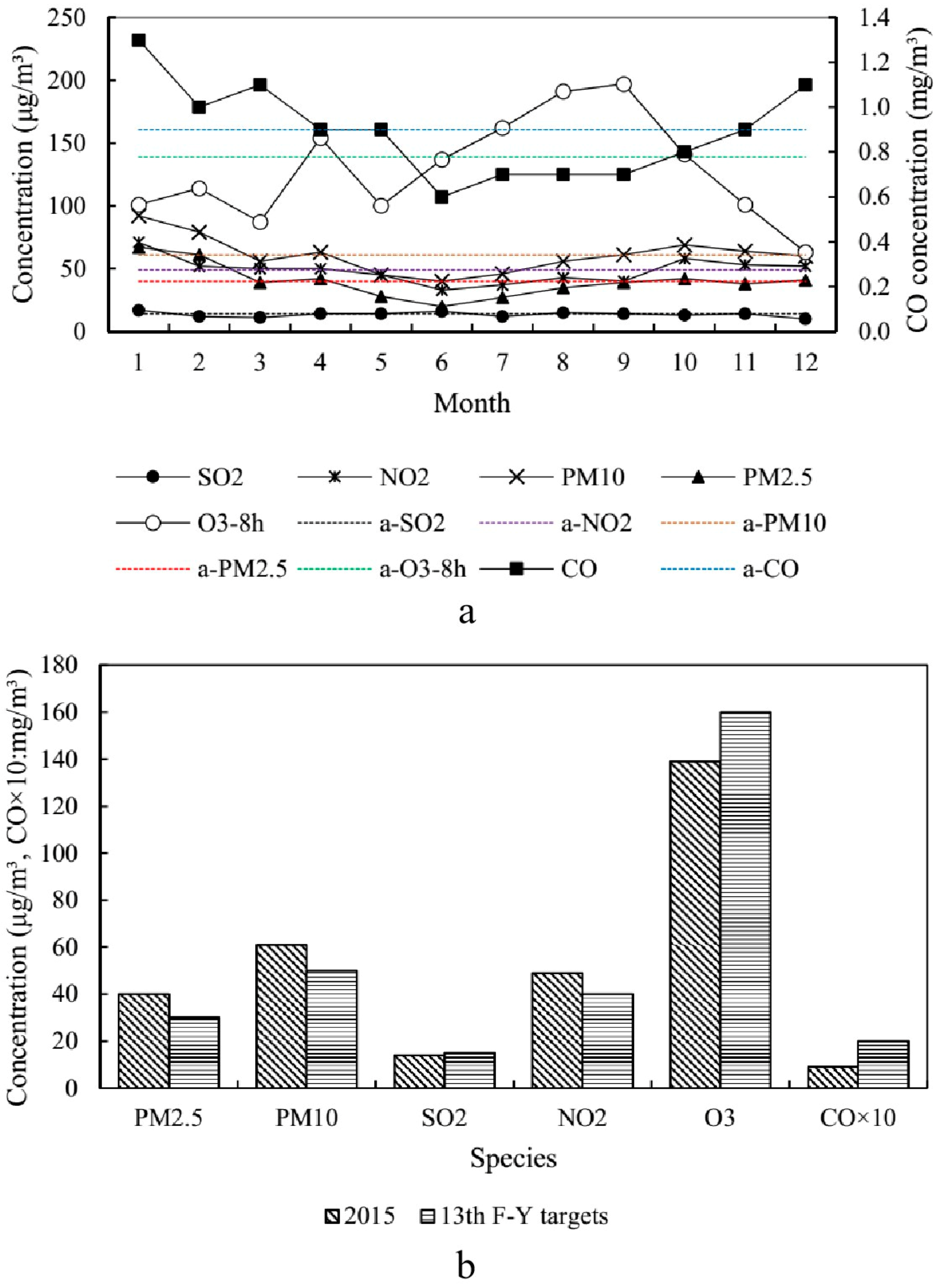
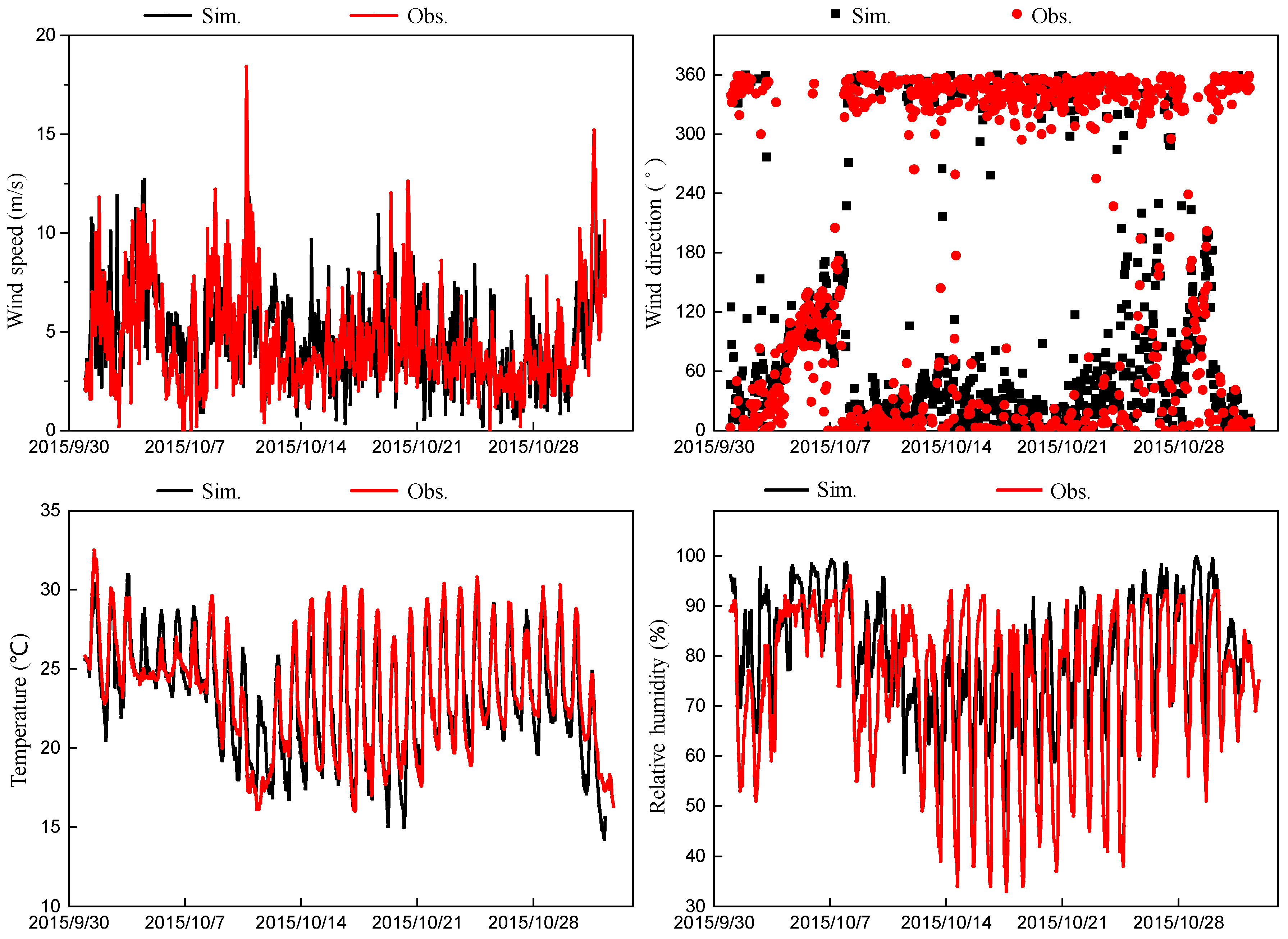
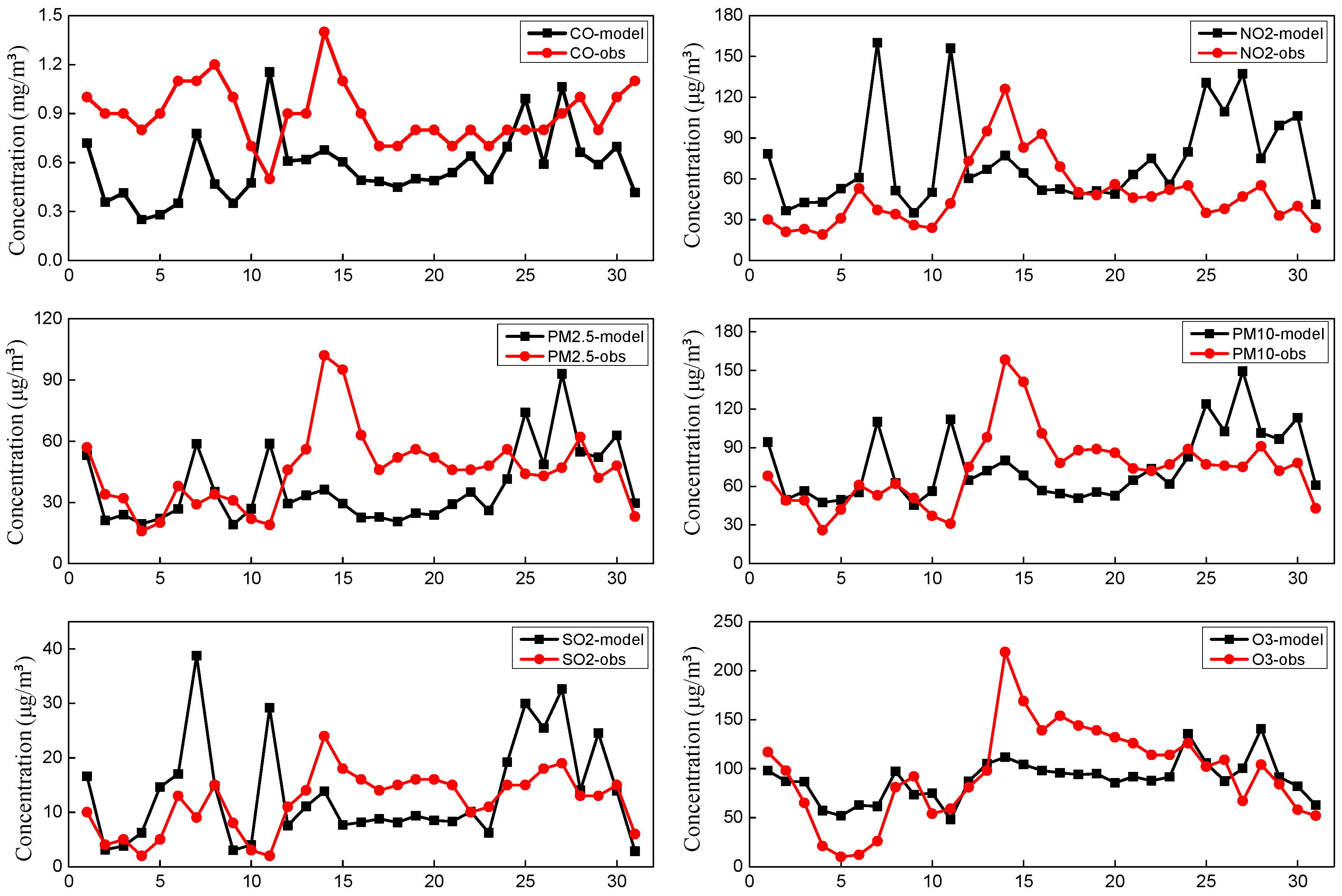
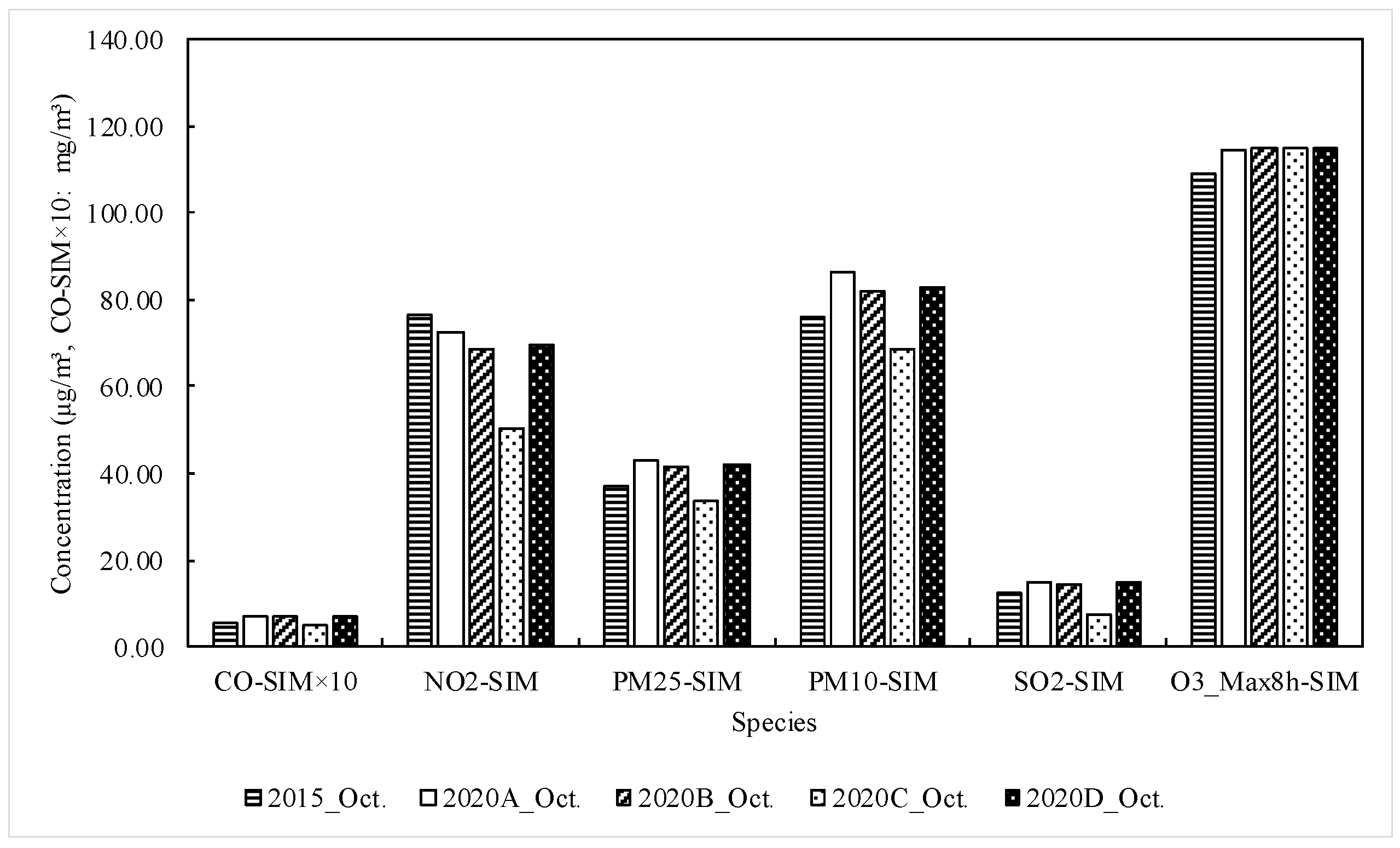
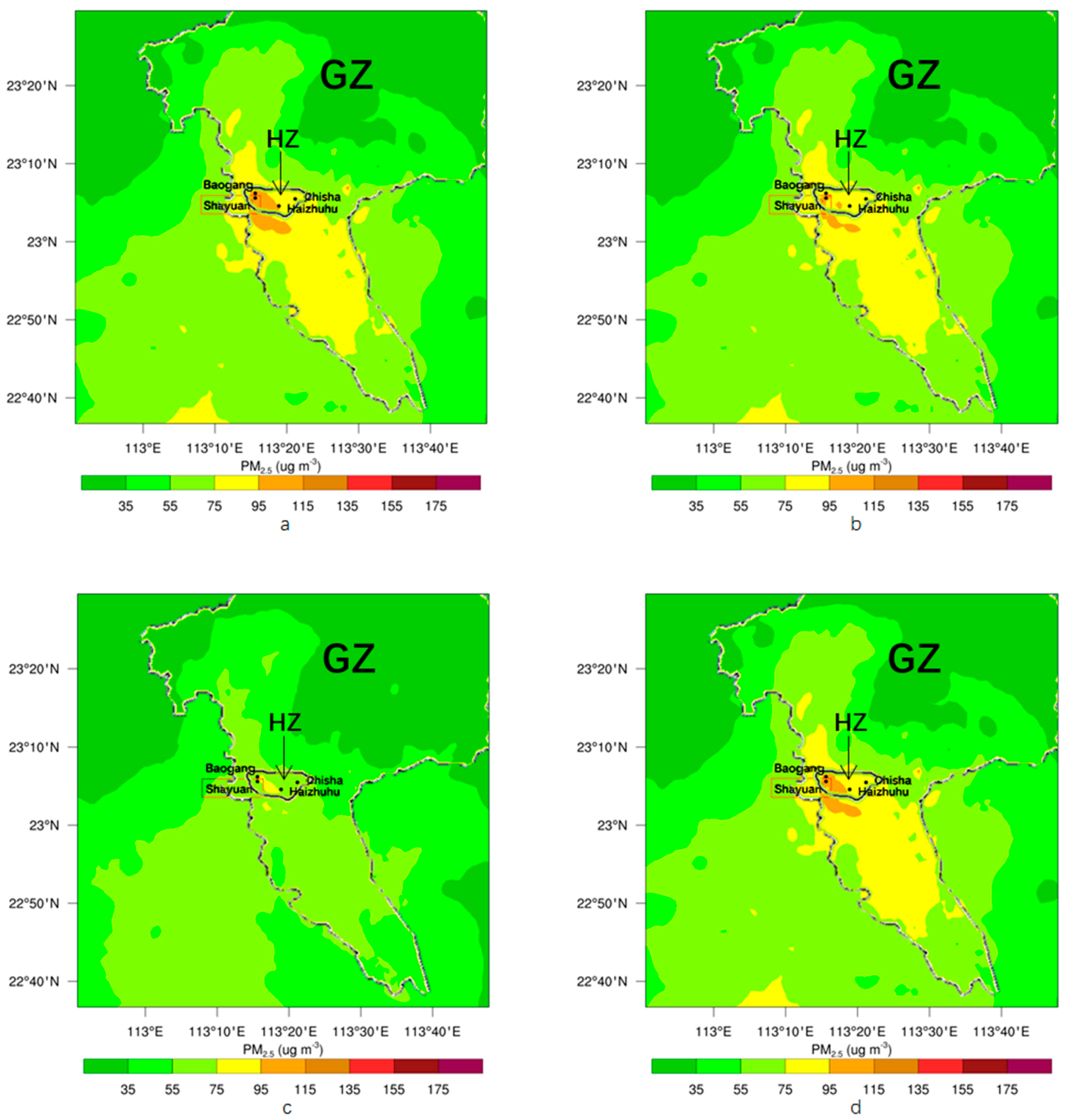

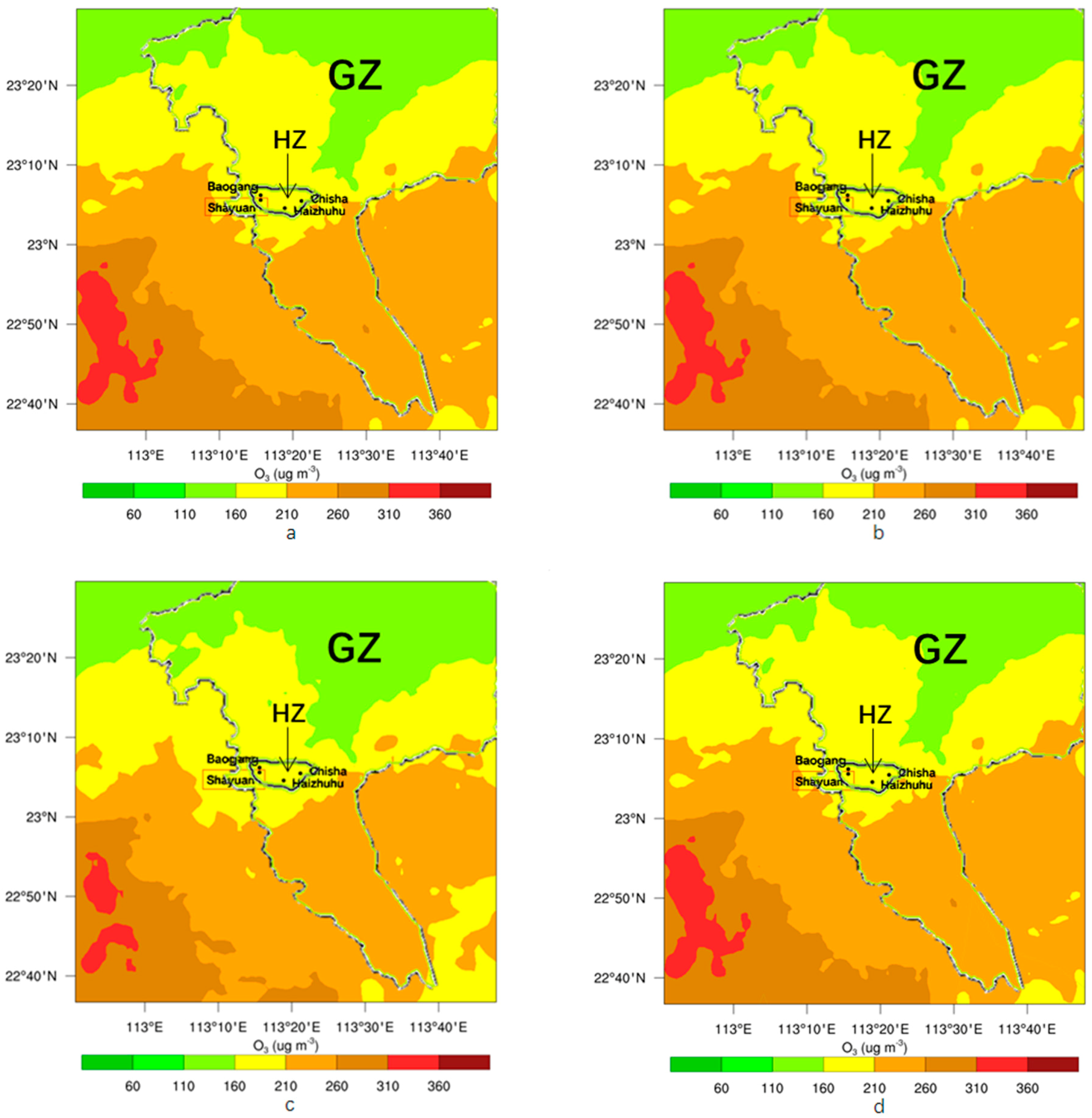
| SO2 | NOx | CO | PM10 | PM2.5 | VOCs | |
|---|---|---|---|---|---|---|
| (A-2015)/2015 | 58.9% | 48.6% | 60.2% | 15.1% | 26.4% | 25.0% |
| (B-2015)/2015 | 57.2% | 47.4% | 60.1% | 14.6% | 25.8% | 24.9% |
| (C-2015)/2015 | −72.9% | −14.2% | 1.0% | −36.7% | −41.8% | −33.2% |
| (D-2015)/2015 | 58.9% | 48.1% | 60.1% | 15.0% | 26.2% | 25.0% |
| Station | Season | Event Frequency (Units) | key Pollutant | Max Pollution Level |
|---|---|---|---|---|
| Baogang | Spring | 5 | PM2.5, NO2, O3 | Moderate pollution |
| Summer | 4 | O3 | Heavy pollution | |
| Autumn | 3 | PM2.5, NO2, O3 | Moderate pollution | |
| Winter | 9 | PM2.5, NO2 | Moderate pollution | |
| Chisha | Spring | 4 | PM2.5, NO2, O3 | Moderate pollution |
| Summer | 4 | O3 | Heavy pollution | |
| Autumn | 3 | NO2, O3 | Moderate pollution | |
| Winter | 7 | PM2.5, NO2 | Moderate pollution | |
| Shayuan | Spring | 7 | PM2.5, O3 | Moderate pollution |
| Summer | 5 | O3 | Heavy pollution | |
| Autumn | 12 | PM2.5, NO2, O3 | Moderate pollution | |
| Winter | 7 | PM2.5, NO2 | Heavy pollution | |
| Haizhuhu | Spring | 6 | PM2.5, NO2, O3 | Moderate pollution |
| Summer | 3 | O3 | Light pollution | |
| Autumn | 10 | NO2, O3 | Moderate pollution | |
| Winter | 12 | PM2.5, NO2, O3 | Moderate pollution |
| Species | Changes in Pollutant Concentrations | |||
|---|---|---|---|---|
| (B-A)/A | (C-A)/A | (D-A)/A | ||
| Winter episode | PM2.5 | −7.15% | −23.42% | −3.18% |
| NO2 | −6.46% | −28.29% | −4.59% | |
| Summer episode | O3 | 0.45% | 0.35% | 0.14% |
© 2020 by the authors. Licensee MDPI, Basel, Switzerland. This article is an open access article distributed under the terms and conditions of the Creative Commons Attribution (CC BY) license (http://creativecommons.org/licenses/by/4.0/).
Share and Cite
Zhan, J.; Wang, M.; Liu, Y.; Feng, C.; Gan, T.; Li, L.; Ou, R.; Ding, H. Impact of the ‘13th Five-Year Plan’ Policy on Air Quality in Pearl River Delta, China: A Case Study of Haizhu District in Guangzhou City Using WRF-Chem. Appl. Sci. 2020, 10, 5276. https://doi.org/10.3390/app10155276
Zhan J, Wang M, Liu Y, Feng C, Gan T, Li L, Ou R, Ding H. Impact of the ‘13th Five-Year Plan’ Policy on Air Quality in Pearl River Delta, China: A Case Study of Haizhu District in Guangzhou City Using WRF-Chem. Applied Sciences. 2020; 10(15):5276. https://doi.org/10.3390/app10155276
Chicago/Turabian StyleZhan, Juanming, Minyi Wang, Yonghong Liu, Chunming Feng, Ting Gan, Li Li, Ruiwen Ou, and Hui Ding. 2020. "Impact of the ‘13th Five-Year Plan’ Policy on Air Quality in Pearl River Delta, China: A Case Study of Haizhu District in Guangzhou City Using WRF-Chem" Applied Sciences 10, no. 15: 5276. https://doi.org/10.3390/app10155276
APA StyleZhan, J., Wang, M., Liu, Y., Feng, C., Gan, T., Li, L., Ou, R., & Ding, H. (2020). Impact of the ‘13th Five-Year Plan’ Policy on Air Quality in Pearl River Delta, China: A Case Study of Haizhu District in Guangzhou City Using WRF-Chem. Applied Sciences, 10(15), 5276. https://doi.org/10.3390/app10155276





